Percy
Member Posts: 22480 From: New Hampshire Joined: 12-23-2000 Member Rating: 4.8
 (1)
(1)
| |
| |
| |

|
Message 36 of 46 (681968)
11-29-2012 6:45 AM
|
Reply to: Message 35 by Coyote
11-28-2012 9:19 PM
|
|
Found a version about halfway down this page:
Hmmm, maybe I can reproduce it here, giving it a try:
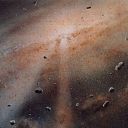 Chaotian Eon
| 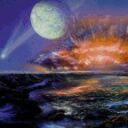 Hadean Eon The name says it all; a hellish period lasting some 760 million years, when the Earth was subject to frequent bombardment by comets, asteroids, and other planetary debris. This era begins when a Mars-sized body struck the original Earth, pulverizing both, and reforming into the current Earth-moon binary. Gradually the molten Earth cools, outgassing of first atmosphere and oceans, bombardment by left-over planetesimal and debris. The Hadean eon was characterized by extensive volcanism and formation of the first crust. Following a second period of cosmic bombardment, by the end of the Hadean, the Earth had an atmosphere (unbreathable to most organisms today), and oceans filled with water. |  Archean Eon Lasting more than twice as long as the Phanerozoic eon, the Archean was a time when diverse microbial life flourished in the primordial oceans, and the continental shields developed from volcanic activity. The reducing (anaerobic) atmosphere enabled Archaea (anaerobic microbes) to develop, and plate tectonics followed a regime of continental drift different to that of the Proterozoic and later. During this era, one type of organism, the Cyanobacteria (blue-green algae) produced oxygen as a metabolic by-product; the eventual build-up of this highly reactive gas was to eventually prove fatal to many life-forms, and converted the atmosphere from.
| 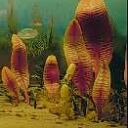 Proterozoic Eon The Proterozoic, which lasted even longer than the Archean Era, saw the atmosphere changes from reducing to oxygenated, driving the original anaerobic inhabitants of the Earth into a few restricted anoxic refuges and enabling the rise of aerobic life (both prokaryote and the more complex eukaryotic cell, which requires the high octane boost that oxygen enables.) Stromatolites (colonial cyanobacteria), which had appeared during the Archean, were common. The modern regime of continental drift began, and saw the formation of supercontinent of Rodinia, and several extensive ice ages. Late in the Proterozoic a runaway icehouse effect meant that the preceding warm conditions were replaced by a " Snowball Earth" with ice several kilometers deep covering the globe. Warming conditions saw the short-lived Ediacarian biota and finally the appearance of first metazoa. | 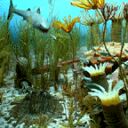 Paleozoic Era Early in the 300 million year history of the Paleozoic, atmospheric oxygen reached its present levels, generating the ozone shield that screens out ultraviolet radiation and allows complex life to live in the shallows and finally on land. This era witnessed the age of invertebrates, of fish, of tetrapods, and (during the Permian) reptiles. From the Silurian on, life emerged from the sea to colonize the land, and in the later Paleozoic pteridophyte and later gymnospermous plants flourished. The generally mild to tropical conditions with their warm shallow seas were interspersed with Ordovician and Permo- Carboniferous ice ages. Towards the end of the Paleozoic the continents clustered into the supercontinent of Pangea, and increasingly aridity meant the end of the great Carboniferous swamps and their unique flora and fauna. The Paleozoic was brought to an end by the end Permian mass-extinction, perhaps the most severe extinction the planet has seen. |  Mesozoic Era Lasting little more than half the duration of the Paleozoic, this was a spectacular time. The generalized archosaurian reptiles of the Triassic gave way to the dinosaurs, a terrestrial megafauna the like of which the Earth has not seen before or since. While dinosaurs dominated the land, diverse sea-reptiles ruled the oceans, and invertebrates, especially ammonites, were extremely diverse. Pterosaurs and later birds took to the sky. Mammals however remained small and insignificant. Climatic conditions remained warm and tropical worldwide. The supercontinent of Pangea broke up into Laurasia and Gondwana, with different dinosaurian faunas evolving on each. During this era modern forms of corals, insects, new fishes and finally flowering plants evolved. At the end of the Cretaceous period the dinosaurs and many other animals abruptly died out, quite likely the result of an asteroid impact and associated extensive volcanism (acid rain) | 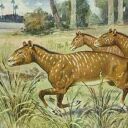 Cenozoic Era With the extinction of the dinosaurs and the end of the Mesozoic, the mammals swiftly inherit the Earth. Archaic mammals co-existed with birds and modern reptiles and invertebrates. The current continents emerged, and the initial tropical conditions were replaced by a colder drier climate, possibly caused by the Himalayan uplift. The appearance of grass meant the rise of grazing mammals, and the cooler drier world allowed modern mammalian groups to evolve, along with other lineages now extinct and a few archaic hold-overs. Among the newcomers were the anthropoid apes that culminated in the australopithecine hominids of Africa. Decreasing temperatures and a polar landmass of Antarctica resulted in a new Ice Age. Most recently, in the blink of an eye geologically speaking, this era saw the rise of Man (Homo erectus, Neanderthal and Cro-Magnon) and use of stone tools and fire, the extinction of Megafauna, and civilization and human activities that have transformed the globe, but at a cost of great environmental destruction. | That should be good enough. --Percy Edited by Percy, : Minor cleanup. Edited by Percy, : Fix links.
| This message is a reply to: | | | Message 35 by Coyote, posted 11-28-2012 9:19 PM | | Coyote has not replied |
| Replies to this message: | | | Message 44 by kofh2u, posted 11-30-2012 6:29 PM | | Percy has seen this message but not replied | | | Message 45 by kofh2u, posted 08-20-2013 9:17 PM | | Percy has not replied | | | Message 46 by kofh2u, posted 10-12-2013 9:40 AM | | Percy has not replied |
|


 ™ Version 4.2
™ Version 4.2